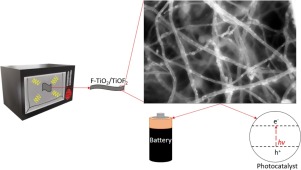Journal of Fluorine Chemistry ( IF 1.7 ) Pub Date : 2019-09-23 , DOI: 10.1016/j.jfluchem.2019.109375 Derek B. Dwyer , Daniel J. Cooke , Marc Francis Hidalgo , Boxiao Li , Jacob Stanton , Fred Omenya , William E. Bernier , Wayne E. Jones

|
Fluorine doped metal oxides have shown great promise for use in many applications including Li-ion batteries (LiBs), photocatalysis and dye-sensitized solar cells. Both F-TiO2 and TiOF2 have been studied extensively for this purpose. However, fabrication of fluorine doped titanium oxide requires the use of dangerous fluorinated chemicals such as trifluoroacetic acid, hydrofluoric acid and fluorine gas which are both difficult to handle and create significant waste detrimental for the environment. Additionally, current procedures for fabrication of F-TiO2 and TiOF2 require long heating times which are inefficient, wasting large amounts of energy. Because of these factors, fabrication of F-TiO2, TiOF2 and of other important fluorine doped metal oxides is expensive and dangerous to make. In this work, two new methods were used to greatly improve the safety and efficiency of synthesis. First, the fluorinated waste was eliminated by using the safe and inert polymer, polyvinylidene fluoride (PVDF), as the fluorine source. Second, microwave (MW) irradiation was used to reduce the time and energy required for synthesis by addition of the MW absorber, graphene, into the precursor material. The results show that when using the PVDF fluorine source with conventional oven heating it results in low levels of F-TiO2 which are dependent on heating temperatures. However, when using microwave irradiation high levels of doping were achieved creating both F-TiO2 and TiOF2 in as little as 6 min compared to several hours. This work has shown that by combining both PVDF and microwave irradiation fabrication of F-TiO2 and TiOF2 can now be done safely and efficiently with greatly reduced environmental impact.
中文翻译:

微波辐射和聚偏二氟乙烯对纳米结构TiO 2的氟掺杂
氟掺杂的金属氧化物在包括锂离子电池(LiBs),光催化和染料敏化太阳能电池在内的许多应用中显示出了广阔的前景。为此目的,已经对F-TiO 2和TiOF 2进行了广泛的研究。但是,掺杂氟的二氧化钛的制造需要使用危险的氟化化学物质,例如三氟乙酸,氢氟酸和氟气,它们既难以处理又对环境造成严重的废物。另外,用于制造F-TiO 2和TiOF 2的当前程序需要较长的加热时间,这是低效率的,浪费大量能量。由于这些因素,F-TiO 2,TiOF的制造2和其他重要的氟掺杂金属氧化物昂贵且制造危险。在这项工作中,使用了两种新方法来大大提高合成的安全性和效率。首先,通过使用安全和惰性的聚合物聚偏二氟乙烯(PVDF)作为氟源,消除了氟化废料。其次,通过将MW吸收剂石墨烯添加到前体材料中,使用微波(MW)辐照来减少合成所需的时间和能量。结果表明,将PVDF氟源与常规烤箱加热一起使用时,会导致F-TiO 2含量低,这取决于加热温度。但是,当使用微波辐射时,实现了高水平的掺杂,同时生成了F-TiO 2和TiOF2在短至6分钟相比数小时。这项工作表明,通过结合PVDF和微波辐射,现在可以安全有效地完成F-TiO 2和TiOF 2的生产,同时大大减少对环境的影响。









































 京公网安备 11010802027423号
京公网安备 11010802027423号